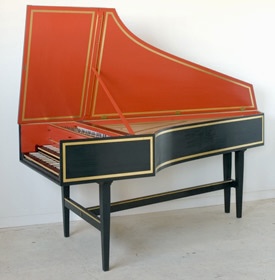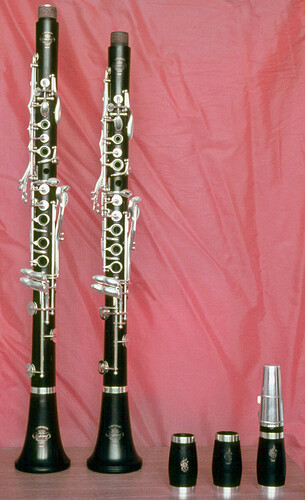Andrew, that is my intention to bring it back to what it once was. I do like the idea of starting out with one 8’ and get that playing perfectly before tackling the others. But yes, bringing the instrument back to its original intended tone and functionality (including the pedals) is the end goal.
There’s no response from the PTG group, and by now the post is buried.
By the way, I have no opinion about where to end up with the restoration of this instrument.
I do wonder if it ever played very well, so I suggest that setting up one rank as perfectly as possible, and testing it well, will give helpful information about where things can go. There are instruments that can’t be regulated very dependably, or can only be regulated with heroic effort, and it would be good to get a sense of the capacities of the instrument. I wonder what kind of strings were on the 16’. Kimball may have had the ability to wind their own bass strings.
As far as developing a stringing schedule goes, it’s not simple in my view, but here is a superb resource from Claudio di Veroli @CDV who is on this forum.
This section relates to developing a schedule for a modern instrument:
Although this may not necessarily be relevant for a revival harpsichord.
If we get into stringing in detail I suggest we start a new topic.
@jsalzer,
I would still like to know whether the strings in the picture taken from above are all brass, or if not where it changes to iron. Also the current pitch of the instrument, please.
David
Thanks Andrew. Of course, I dealt with Baroque French instruments, with a different scaling altogether. But there is a principle that is valid always. If you know a proper stringing from a few strings in the bass, midrange and treble, the rest can be calculated (and my webpage shows how): you just try to have a transition of “pulls” as smooth as possible.
Thanks again for all the replies and very informative suggestions. I will try to answer some questions here.
Regarding the current strings - the strings are not the originals. When I bought the instrument, it was playable but the strings rusted and had seen better days. I didn’t know much about harpsichords and I was naive enough to think I could restring this beast with just some “googling”. So the strings on the picture are my horrible (and inaccurate) attempt at restringing it. Before began restringing it, I asked in a few forums. I don’t recall now which forum it was but someone sent me a stringing schedule for a harpsichord. I believe it was that of a French double, but I could be mistaken. The strings on the instrument are based on the material and thickness from that string schedule I was given on a forum a few years ago. I am sure it is completely wrong for my instrument. I didn’t know any better then, nor did I really have the time and $ required to work on the Kimball. I am now at a place where I can finally tackle the project.
String singing length - I took a measurement of the singing length for c above middle c (c’) for the longest 8’ and it measures right around 350mm or 35cm. I have not measured it for the shorter 8’ or for c’’. I’ll be happy to take more measurements and any requested pictures.
Original strings - I am not sure if I still have the original strings somewhere but I can look for them. From what I remember, the original strings were pretty brittle and would easily break, which is what prompted me to restring it.
Pitch - currently the harpsichord is not tuned. I could tune some strings but not sure if A440 or A415 is the proper tuning for this instrument or if it even matters.
Anyway, please ignore the current strings, material, etc.
As always, I really appreciate all the help!!
Dear jsalzer: you need to measure the speaking lengths of ALL the 4’ strings and also ALL the 8’ strings of the longest choir (left of each pair). You need this information to estimate the pitch the instrument was meant from (most likely A=440) and to calculate a stringing list (alloy and diameter for each string) that
- Will not yield broken strings.
- Will sound decently and evenly.
As for the 16’, there the breaking risk is minimal (strings are surely too short for that), but on how to calculate a 16’ stringing list I confess my ignorance.
Claudio thanks so much for the clarification! I will measure the speaking length of the 4’ an and 2x8’ as requested. I should be able to do this tonight or tomorrow. Once I get the 4’ and 8’s strung I’ll worry about the 16’ later.
Thanks again!
It would be extremely unusual indeed for a revival instrument to be at any pitch other than A440. The point about measuring the scaling is not really to establish pitch in this case. I think A440 is a given here.
I agree Andrew, though German orchestras would often be as high as A=448 in mid-20th century.
Not relevant. This is an American instrument. I never heard of a revival instrument being at other than A440, neither higher nor lower. And it’s not an orchestral instrument.
448? Often? Never heard of any such thing. Where would they get 448 oboes? I wouldn’t want to subject my violins to 448.
Oboes now are 442 or 443, but that high?
Where is the evidence Claudio?
[This is off topic. We should start a new topic - very high pitch.]
Dear Andrew.
I have the evidence.
During the 1970-1980s I played chamber music with oboist Sofia Koliren in Buenos Aires. She was back from Germany where she had played for a time under Karl Richter. There she purchased her oboe, precisely in A=448. In Buenos Aires she had it slighly lowered. However, under the influence of German oboes, Buenos Aires orchestras had for decades a pitch as high as A=445.
Local clarinet players often had specially “cut barrels” for that very reason: I played the clarinet professionally at the time, and I had one such barrel.
I attach a picture of my clarinets, taken in 1967. Originally meant for A=441, Note the three barrels, needed to play at higher pitches. I had also a 4th smaller barrel.
See also German Orchestras as high as A=448
Hi all I have not forgotten to measure the speaking length of the strings. Just taking longer than expected, definitely more work than I anticipated, especially the the crappy measuring tape I am using. I should have all the measurements this weekend.
One thing I wanted to ask regarding the Kimball harpsichord. It has been on through 3 moves and as a result the veneer has some dings, chips, some lifting at the front, etc. Before I knew how rare the instrument was, my intention was to paint it. I wanted to go for this look as the harpsichord on the picture resembles the shape and size of my Kimball. However, now I am not sure if from a preservation perspective it would be best to repair the veneer and try to match the original color on the repairs.
Just curious on what others think. Since I’ll be removing all the strings this would be the time to paint it if I will be going that route. Here’s a picture of what I envisioned. The harpsichord will be permanently placed in my library.

Your Kimball instrument is as far away from a French double as it is possible to get. Pretending it is one by using an 18C French decorating scheme is absurd. An anachronism. Since this is a rare instrument of a certain amount of interest I think you are obliged to preserve its original state as much as possible. The general museum curatorial policy nowadays is to only make moves that can be reversed (e.g. stringing_ or leave intact. Live with the veneer defects - it’s the patina of age and wear. Glue down the lifted veneer, but using animal glue is probably the best.
Re scale, it’s 13.8 inches. That is, as expected, exactly what one would expect for a revival instrument. They were always long scaled for modern steel wire.
So that means we know that A440 and steel wire is the answer.
I mentioned previously I think you should use Roslau wire, available from any piano supply house and Marc Vogel. For brass, I referred you to Little Falls but @hpschdNU pointed out they have large inudstrial size minimum orders. Brass is also readliy available from Marc Vogel and @hpschdNU also sells wire for harpsichords. For this sort of instrument red brass was not used - it was not generally available at that time. So use plain yellow brass wire.
I’m pretty sure you are going to need wound strings for the bottom of the 16 foot. You can make them yourself if you are really keen, but there are places that will make them to specification. I’d recommend you leave that matter well alone until you have 8, 8, and 4 going.
Get a good micrometer! The new snazzy digital ones make life much easier too. For example, this well regarded brand:
I am in the process of measuring ALL the speaking length for my strings. The 2x8, the 4’ and the 16’.
I figured I would draw up a spreadsheet to make it easier easier. But being as lazy as I am, I had ChatGPT do it for me. I asked it to give me every note on a piano keyboard from F1 to G5 and put it in a table format. A few seconds later, it had it done for me. Again, I could have copied and pasted the table into excel, but being lazy again I asked ChatGPT to covert the table into excel format and provide me the file to download. Sure enough, did it in a few seconds.
Saved me tons of time.
You would have saved even more time asking me for such a spreadsheet, providing all the frequencies with the basic A pitch you wish, with cells for the string lengths, and including all the tension calculations. ![]()
Fully agree with Andrew 's post!
It would also be good to know the following:
a. is it covered on the bottom, or is the bottom opened as in pianos?
b. if the bottom is opened (as I suspect), you can inspect the soundboard from both sides: put a strong light and watch from the other side. Especially watch the grain: if it has different direction then the soundboard is laminated (as in most German revival instruments). If so, the sound is hopeless no matter the care you have with stringing et. al.
